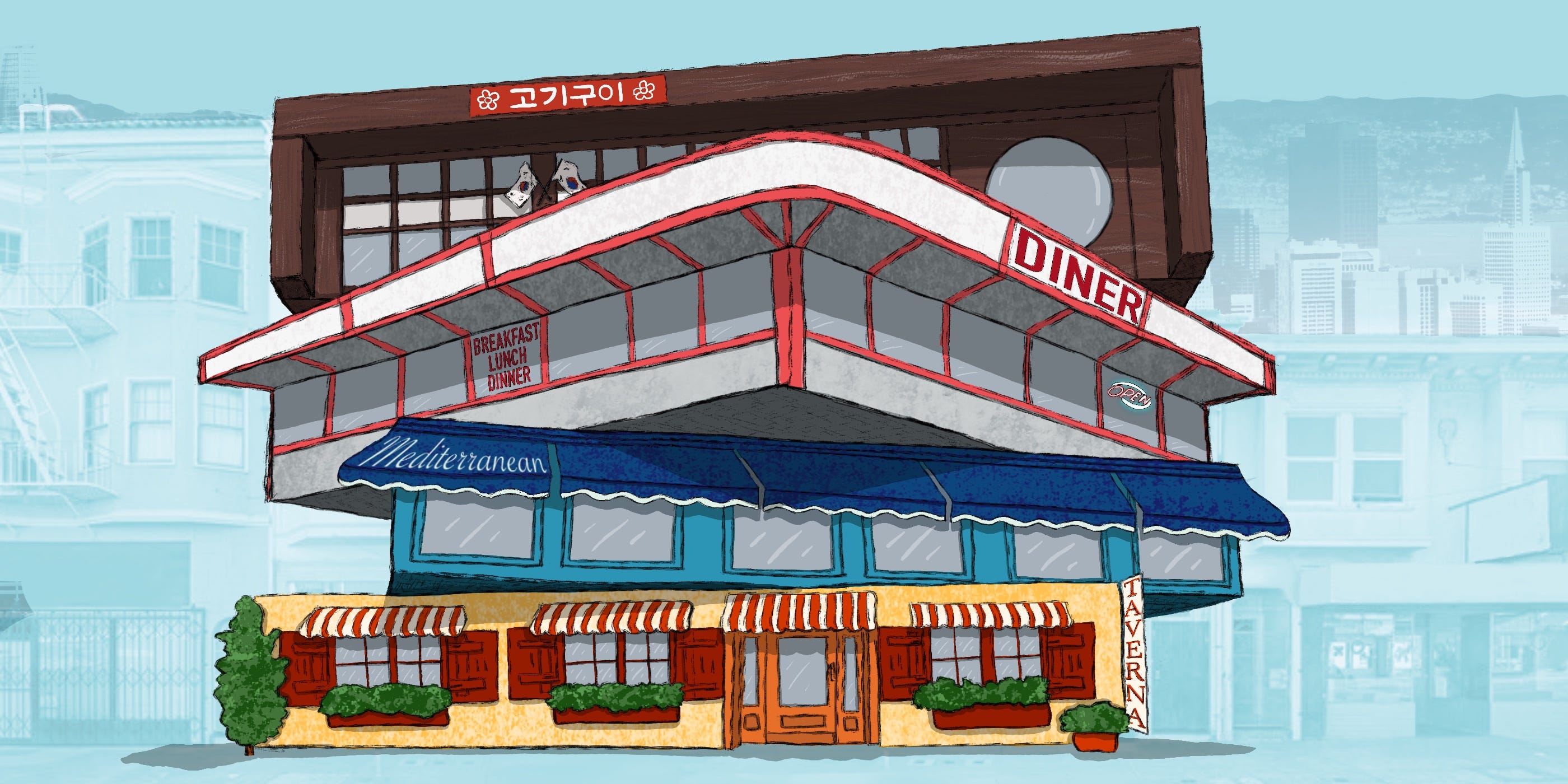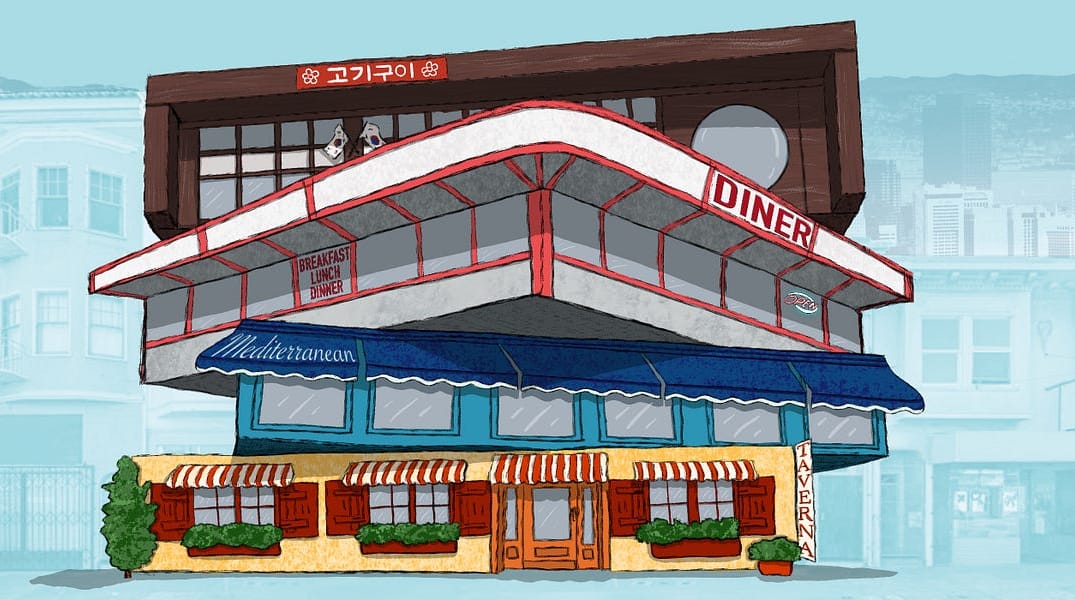
Welcome to the pivot restaurant. The next time you stop by, it might not be what you remembered. A new strategy is emerging in the local dining scene that doesn’t involve empty retail spaces (RIP, Mission Pie) and sad Instagram posts (we miss you, Flora). Instead of closing shop, some restaurateurs and chefs have chosen to change direction.
Case in point: Cow Marlowe (the Marina outpost of Marlowe), which closed briefly this past August. The space reopened in October as the redesigned, health-forward Greenwich under the same ownership. Or Prairie, the Mission eatery by chef Anthony Strong, which opened in October 2018 with a “new-school Italian” direction. Less than a year later, it was rebranded as “a modern live-fire grill.” Che Fico’s downstairs casual diner, Theorita, lasted six months after opening and served its last piece of pie in December of last year. But since April, the team has been serving a decadent Italian menu at Che Fico Alimentari in the same space.
And there’s the biggest pivot of them all: Foxsister, the Outer Mission comfort-food Korean restaurant that lasted a little under two years. It was recently reborn as the Italian eatery Great Gold under the same management. One restaurant pivoted to red-sauce comfort, while another turned away from it — kind of. Cow Marlowe adjusted itself according to the neighborhood’s needs, while Che Fico Alimentari was the result of streamlining and rethinking the business model.
Every pivoting business shared a similar attitude: getting creative in a competitive business environment and serving up something new while swallowing their pride.
The fact that the local dining scene is brutal isn’t news; for a number of years, voices in the industry have been complaining about the rapidly growing rents, the skyrocketing price of liquor licenses, and the increasing cost of staff wages. It makes sense that when the space is secured, the perils of licensing left behind, and the staff hired and trained, the last thing restaurant owners want to do is close and start all over.
“What felt natural at first was Italian, more updated and more fun. As we were in the space and getting our footing, the restaurant started dictating the direction.”
“Foxsister wasn’t working from a financial standpoint — the check was very low; people ordered beer and wings; and they didn’t treat it as a dining destination,” says David Steele, owner and manager with partner Brandon Kirksey. Steele considered terminating the business, but then something clicked when he realized that instead of closing and selling the restaurant to a new buyer, he could reimagine the narrative. “We’ve already spent a year developing an Italian restaurant at a different location,” Steele says, so the two decided to use Foxsister’s space for the upcoming project instead. The founding partner of the Ne Timeas Restaurant Group (Four + Water, Central Kitchen, Salumeria), Steele knew that Italian is a solid bet, attracting more dinnertime customers than drink-and-snack customers.
Anthony Strong of Prairie also flocked to Italian food with his first solo business after a long stint with the pizza-famous Delfina Restaurant Group, but what was at first a safe bet has since evolved. Strong initially filled Prairie’s menu with adventurous pastas and appetizers, but then he lost his inspiration. “What felt natural at first was Italian, more updated and more fun. As we were in the space and getting our footing, the restaurant started dictating the direction,” he says.
Working with charcoal and wood-burning grills, Strong decided to “lean heavier” in to his resources, downsizing to only one pasta dish and adding steak and grilled-vegetable items, like scallop-butter-filled cabbage and grilled avocado. The guanciale-wrapped mochi, a “polarizing dish,” was axed in the process. “The restaurant is maturing in the direction we’re meant to go at. We’re doing ‘Americana.’ The city is packed with Italian restaurants [already],” Strong says.
When partners David Nayfeld, Angela Pinkerton, and Matt Brewer opened the ambitious Che Fico on Divisadero in March 2018, they struck gold. Later that year, Che Fico was named one of the nation’s best new restaurants by Bon Appétit, and reservations at dinnertime have been hard to come by since. But Theorita, the diner-meets-pie-shop casual spot in the building’s downstairs space that opened roughly half a year after, wasn’t seeing the same success. “We really wanted to highlight Angela’s talents with pies and sandwiches, but the rent was high, and we had to do dinner service and serve beer and wine to help [cover] the costs of the bakery,” says Brewer. “The economics didn’t work out.”
Closing entirely, however, wasn’t an option since the partners loved the neighborhood and the space and were committed to investors. They decided to reinvent the space as Alimentari, a lower-price-point version of the popular upstairs restaurant. Taking inspiration from Roman trattorias, the team constructed a menu that featured Che Fico’s salumi program, adding a cornucopia of cheese dishes and a selection of comforting dishes based on dry pasta. “We just hit our six-month mark, and we’re profitable. We’ve seen a lot of regulars and return clients,” Brewer reports.
Ego, a frequent ingredient in restaurant kitchens worldwide, has to be checked in the Bay Area nowadays.
If it sounds like running an affordable, casual spot in San Francisco is mission impossible unless you’re Souvla, Brewer thinks that the main issue was a lack of focus. “If we just had burgers and fries and pies, we could have made it work,” he says.
And with every successful pivot, there’s a learning opportunity. “You have to be able to put your ego aside and realize pretty quickly when something isn’t working and change it,” Brewer says.
Ego, a frequent ingredient in restaurant kitchens worldwide, has to be checked in the Bay Area nowadays. Instead, restaurateurs and chefs are learning to be flexible about changing a concept if it isn’t giving them the numbers. In fact, after I spoke with these restaurant owners and chefs, the impression I got was that the days of the steady, one-trick-pony restaurant might be over. In a city flooded with experiential dining, pop-up restaurants, and one-night-only ticketed dinner events from up-and-coming chefs (via platforms like Feastly and Tock), even those who have the funds to secure a permanent brick-and-mortar need to constantly question to retain traction.
Next year, Strong admits, he’ll change things up at Prairie again, reducing the menu to casual bar food and adding more elaborate one-night dinners with a different menu in each installment. The change will allow for more creative freedom in the kitchen. Diners will have to purchase tickets ahead of time.
This just might be the right move in a financially challenging city occupied by a thrill-chasing, disruption-seeking clientele. Sometimes, the need for revenue is the main motivation behind the pivot, but for others, it’s the pure thrill of hitting Refresh.







